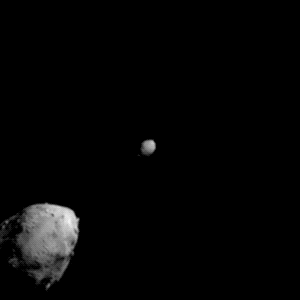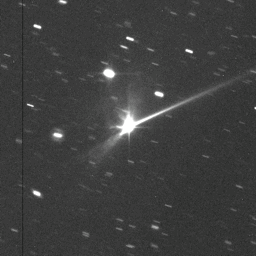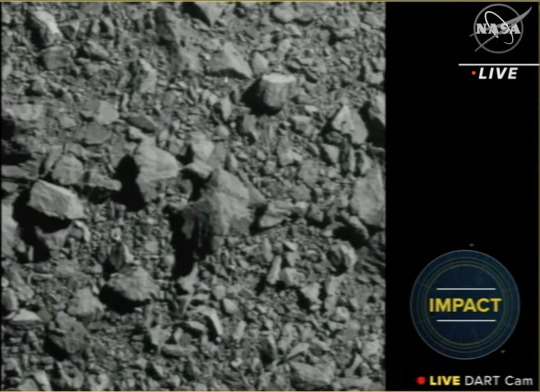#Double Asteroid Redirection Test
Text
GOOD MORNING EVERYONE, LAST NIGHT WE SUCCESSFULLY PWNED AN ASTEROID
#dart#double asteroid redirection test#space#nasa#asteroid#asteroids#this one goes out to the dinosaurs#universe#astronomy#science#physics#astrophysics#my post
302 notes
·
View notes
Text
While most folks were sitting down for supper, NASA tried to move a space mountain.
Beyond sight for backyard stargazers, a spacecraft the size of a vending machine self-destructed by ramming into a harmless asteroid shortly after 7 p.m. ET Monday, September 26th. The high-speed crash was part of the U.S. space agency's Double Asteroid Redirection Test, or DART.
The moment of impact marked the first time in history humans have attempted to alter the path of an asteroid, a flying chunk of rubble left over from the formation of the solar system about 4.6 billion years ago. Most of the time, these ancient rocks pose no danger to Earth, including Dimorphos, the one NASA just used for target practice. But at least three have caused mass extinctions, the most infamous of which wiped out the dinosaurs.
Stegosaurus didn't have NASA.
"We are changing the motion of a natural celestial body in space. Humanity has never done that before," said Tom Statler, program scientist. "This was the substance of fiction books and really corny episodes of Star Trek from when I was a kid, and now it's real."
(continue reading)
191 notes
·
View notes
Text


Observations of DART impacting Dimorphos, from Hubble and Webb respectively.
https://www.nasa.gov/feature/goddard/2022/webb-hubble-capture-detailed-views-of-dart-impact
#DART#Double Asteroid Redirection Test#NASA#Hubble Space Telescope#James Webb Space Telescope#Hubble#JWST#Very excited about this!#Space Stuff
94 notes
·
View notes
Text

Impact!
Today, the Double Asteroid Redirection Test (DART) spacecraft ended its mission to see if we're able to change a planet-killing asteroid's course by essentially slamming a heavy box with a big engine into it at 4.1 miles (6.6 kilometers) per second.
It will take a few weeks of observation here on Earth to find out if the asteroid's course was indeed altered, but we have at least learned that we are able to successfully target and hit an asteroid from Earth, and that's a pretty big deal!
For more info, see:
#dart#double asteroid redirection test#nasa#space#science#asteroid#dimorphos#didymos#astrophysics#impact
74 notes
·
View notes
Video
undefined
tumblr

DART Mission
The final moments from the DART Mission on its collision course with asteroid Dimporphos.
#DART Mission#double asteroid redirection test#asteroid#asteroid dimporphos#nasa#space#solar system#astronomy#spacecraft#space ship#video
24 notes
·
View notes
Text
Scotty reacts to the DART mission
15 notes
·
View notes
Text


The Didymos System has grown a tail after DART’s impact.
This tail is entirely made of dust being blown out of the system by the solar wind. I’m looking forward to seeing how the system continues to evolve, and how long this tail lasts!
12 notes
·
View notes
Photo

Spaceprobe meets asteroid
10 notes
·
View notes
Photo

SOAR Telescope Catches Dimorphos’s Expanding Comet-like Tail After DART Impact
NASA’s Double Asteroid Redirection Test (DART) spacecraft intentionally crashed into Dimorphos, the asteroid moonlet in the double-asteroid system of Didymos, on Monday 26 September 2022. This was the first planetary defense test in which an impact of a spacecraft attempted to modify the orbit of an asteroid.
Two days after DART’s impact, astronomers Teddy Kareta (Lowell Observatory) and Matthew Knight (US Naval Academy) used the 4.1-meter Southern Astrophysical Research (SOAR) Telescope [1], at NSF’s NOIRLab's Cerro Tololo Inter-American Observatory in Chile, to capture the vast plume of dust and debris blasted from the asteroid’s surface. In this new image, the dust trail — the ejecta that has been pushed away by the Sun’s radiation pressure, not unlike the tail of a comet — can be seen stretching from the center to the right-hand edge of the field of view, which at SOAR is about 3.1 arcminutes using the Goodman High Throughput Spectrograph. At Didymos's distance from Earth at the time of the observation, that would equate to at least 10,000 kilometers (6000 miles) from the point of impact.
5 notes
·
View notes
Text
Wake up, new planetary asteroid defense just dropped
So NASA just successfully whacked an asteroid with a space probe in the first-ever test of a planetary defense system.
https://www.nasa.gov/press-release/nasa-s-dart-mission-hits-asteroid-in-first-ever-planetary-defense-test
It’s called the Dual Asteroid Redirection Test and that abbreviates to DART which I love. The idea is that if a rogue asteroid is headed in toward Earth to kill everyone like the dinosaurs, can we successfully slap it with a small but fast satellite enough to disturb its orbit and deflect it away?

The big challenge is navigation; asteroids move fast and are small making for a challenging target.

I’d say

NASA did

just fine

You can watch the whole video of the final moments of the mission at https://www.youtube.com/watch?v=4RA8Tfa6Sck.
Oh and for fun, you might want to Google “NASA DART” sometime soon... Google has added a bit of stealth code re-enact the impact of the DART satellite on your search results ;)
#nasa#dart#planetary defense#asteroid#double asteroid redirection test#space#science#cool cool cool#google
4 notes
·
View notes
Text
holy shit look at this gif of the DART spacecraft hitting the asteroid, it looks like science-fiction

ATLAS observations of the DART spacecraft impact at Didymos
#nasa#space#science#astrophotography#atlas#dart#double asteroid redirection test#astrophysics#my post#asteroid#asteroids#stars
104 notes
·
View notes
Text
In 2020 Leonardo Amaral, an amateur astronomer in Brazil, discovered another near-Earth asteroid, 2020 QU6, while using an observatory near São Paulo. The object came no closer to Earth than 20 million miles — about 84 times the distance between Earth and the moon — but prompted interest in helping amateur astronomers to find and track objects that could pose a threat to the planet.
“The big professional search programs that NASA is funding are doing, by far and large, the heavy lifting in discovering new objects,” said Davide Farnocchia, a navigation engineer at J.P.L. who works with the Center for Near-Earth Object Studies, or CNEOS. “But that doesn’t mean that we cannot use help from additional people, which includes professional astronomers from other countries but also amateur astronomers. We like to get as many as possible so that we can get the best possible estimate of the trajectory.”
There are plenty of objects to find. Most asteroids in the solar system orbit the sun in the region between Mars and Jupiter, more than 3.2 astronomical units — 3.2 times the distance between the sun and Earth — away from and never approaching our planet. Asteroids are considered near-Earth objects if they approach within 1.3 astronomical units, and there are several hundred million objects smaller than 460 feet wide in that category, Dr. Farnocchia said.
To pose any serious threat to Earth, an object would have to be more than a dozen times as large as 2023 BU. Even if a smaller object like 2023 BU were on track to strike Earth, it would probably disintegrate in the atmosphere, perhaps casting some debris as small meteorites.
In 2005, Congress ordered NASA to identify 90 percent of the near-Earth asteroids that were 460 feet wide or larger, capable of destroying a city. In September, NASA’s Double Asteroid Redirection Test, or DART, mission tried out one possible defense against such objects. The spacecraft, which launched in late 2021, made impact with Dimorphos, a 550-foot-wide asteroid millions of miles from Earth. The mission was deemed a success after the rock’s orbit was shortened by 32 minutes.
— Newly Discovered Asteroid Passes Close to Earth
#anastasia marks#current events#astronomy#physics#asteroids#gennadiy borisov#leonardo amaral#davide farnocchia#nasa#center for near-earth object studies#double asteroid redirection test
0 notes
Text


“Analysis of data obtained over the past two weeks by NASA’s Double Asteroid Redirection Test (DART) investigation team shows the spacecraft's kinetic impact with its target asteroid, Dimorphos, successfully altered the asteroid’s orbit.”
https://www.nasa.gov/feature/nasa-dart-imagery-shows-changed-orbit-of-target-asteroid
https://www.nasa.gov/press-release/nasa-confirms-dart-mission-impact-changed-asteroid-s-motion-in-space
0 notes
Text
“These findings add to our fundamental understanding of asteroids and build a foundation for how humanity can defend Earth from a potentially hazardous asteroid by altering its course.” Nicola Fox, NASA’s associate administrator for the Science Mission Directorate
1 note
·
View note
Photo

The Didymos-Dimorphos Asteroid
The Hubble Space Telescope captured a new snapshot of the asteroid that NASA recently slammed with a spacecraft in an attempt to knock it off course, and the image reveals the clearest look yet at some unexpected results from the mission — a twin tail of dust trailing behind the asteroid system.
The image, released Thursday, is one of 18 observations that the Hubble telescope has made of the Didymos-Dimorphos asteroid system since NASA’s Double Asteroid Redirection Test, or DART, mission crashed a probe into Dimorphos in September.
#The Didymos-Dimorphos Asteroid#The Hubble Space Telescope#Double Asteroid Redirection Test#DART#nasa#nasa photos#nasa picture of the day#space#astronomy#beauty#beautiful#pretty#amazing#blue
13 notes
·
View notes
Text
Bullseye! How DART hit an asteroid 7 million miles away
Bullseye! How DART hit an asteroid 7 million miles away
Bullseye! How DART hit an asteroid 7 million miles away – CBS News
Watch CBS News
NASA’s mission to change an asteroid’s path, as a test of a way to deflect planetary objects that threaten Earth, succeeded at striking a tiny moonlet 7 million miles away. Correspondent David Pogue looks at what the results of the Double Asteroid Redirection Test (DART), and its new technologies, may mean for…
View On WordPress
0 notes